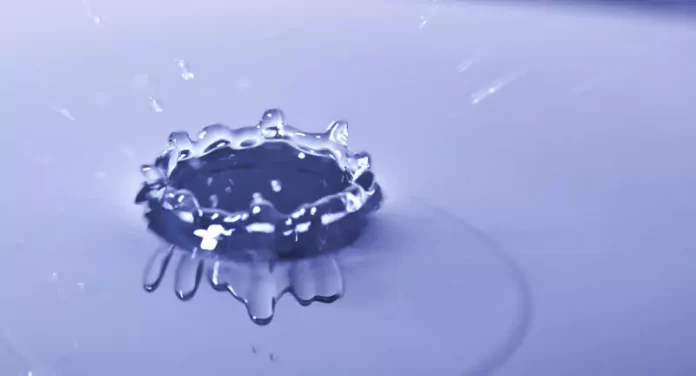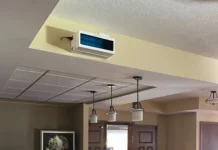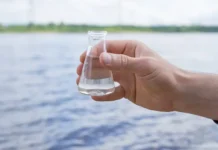By Bailey Jones, MS Student, Department of Civil and Environmental Engineering, University of New Hampshire; and James P. Malley Jr., Ph.D., professor of civil and environmental engineering, University of New Hampshire
The contamination from per- and poly-fluoroalkyl substances (PFAS) in drinking water is prevalent across the globe, and finding cost-effective and sustainable solutions to destroy these compounds has been a challenging task for the water industry. Traditional applications of UV disinfection are not able to destroy these compounds, but research funded by the United States Department of Energy (DOE) may have found an application of UV that can destroy PFAS.
The research, published in Environmental Science: Water Research & Technology¹, explores a promising method of producing reactive oxygen species (ROS), which can disrupt the carbon-fluorine bond in PFAS. The research focuses on using UV-Fenton chemistry catalyzed by nanosized-magnetite (Fe3O4) particles in aqueous environments to produce ROS. The article summarizing this research states, “Here we demonstrate greater than 90% degradation efficiency for a wide variety of PFAS compounds by ROS generated in a UV-Fenton reaction, involving naturally occurring Fe3O4 nanoparticles.”
The early results of this research are promising, but the industry still is far from having a straightforward way to use UV light to degrade PFAS. The article continued: “PFAS destruction occurred with UV exposure times on the order of minutes.” The contact time for conventional UV systems is far less than a minute, meaning that these systems cannot be altered easily to promote UV-Fenton reactions. While full-scale implementation of this technology is not yet available, this research shows that UV-based technology still has unexplored potential in the water industry.
Colorado moving toward water reuse
The population of Colorado is increasing while the amount of available water is not. To keep from running out of water, Colorado has begun discussing water reuse to increase the volume of clean drinking water produced. Colorado’s water quality agency “gave unanimous preliminary approval to regulate direct potable reuse – the process of treating sewage and sending it directly to taps without first being dispersed in a larger water body,” according to an article from CBS News.²
If a final vote in November is in favor of this idea, then Colorado would become the first state to adopt direct potable reuse regulations. Public support for this type of reuse has been questionable at best in the United States, but as droughts become more frequent, the need for water reuse is becoming clear. The reason Colorado feels it can adopt these regulations partially is due to UV disinfection technology.
The water utility in Castle Rock, Colorado, is a facility that, if these regulations are adopted, will have its treated water sent directly to a water treatment plant. The effluent from this facility already meets the proposed regulations on direct potable reuse thanks to a combination of ozonation, granular-activated carbon filtration and UV disinfection used in the facility. Other wastewater facilities in the US practicing UV disinfection similarly may be capable of directing their effluent to a drinking water treatment plant if regulations around direct potable reuse are passed in their states.
Texas announces Rain Catcher Award
The Texas Water Development Board has announced five winners of the 2022 Texas Rain Catcher Award. This award is a rainwater harvesting competition created “…to promote technology, educate the public and to recognize excellence in the application of rainwater harvesting systems in Texas.”³ As regions of Texas experience frequent droughts, capturing and utilizing rainwater is a priority for the state to ensure there is enough water to support its population. One winner in the agricultural category of the award is using UV-filter systems to treat collected rainwater.
Bill Nash/Raven Canyon LLC distributes collected rainwater to its fruit trees all year round. Since there is not enough water in the area to support the facility, it would need to procure water from an outside source. By collecting rainwater, the company avoids the costs associated with buying water and avoids putting undue stress on its local water supply. The entire canyon is managed for rainwater collection. According to an article in WaterWorld, “The system includes three pressurized UV-filtered systems, a 10,000-gallon concrete reservoir, three 2,500-gallon accessory storage tanks, plus nine rock dams and two stock tanks located at the bottom of the canyon.”4 This type of system could be implemented in other regions of the US facing insufficient water supplies.
A UV solution to clean up King’s Beach
King’s Beach in Swampscott, Massachusetts, has tied for the most polluted beach in the state over the past six years. The pollution comes from stormwater runoff containing bacteria being discharged near the beach. This discharge caused the beach to be deemed unsafe for almost one-third of the days in 2021. The town is considering a plan to make the beach safe once more using UV disinfection.
The Swampscott Select Board, “…endorsed Town Administrator Sean Fitzgerald’s recommendation to proceed with the continued study and potential pursuit of an ultraviolet light system to disinfect stormwater runoff onto King’s Beach,” wrote local journalist Scott Souza.5 The type of UV system that the town is discussing already is in use in Newport, Rhode Island. By implementing a UV system, the town would not only be protecting the beachgoers at King’s Beach but also would be reducing the amount of biological pollution that is being sent into the aquatic environment from its stormwater.
H2O Innovation applying UV to aquaculture
A Quebec-based company, H2O Innovation, has announced that it has been awarded 10 new water treatment projects. One project is of particular interest to the UV industry as it focuses on water reuse in the aquaculture sector.
Aquaculture consists of the cultivation and harvesting of fish in a controlled environment. These controlled environments typically are large tanks placed on land, each housing hundreds of fish. To keep such a facility in operation, large volumes of clean water need to be introduced to the fish tanks each day. For example, the facility that commissioned the reuse project recirculates 30 million gallons of water daily.
To treat such a large volume of water, “H2O Innovation has been selected to complete the design, manufacturing, and start-up of [a] reuse system that includes reverse osmosis (RO), granular activated carbon (GAC) and UV disinfection technologies,” according to Canadian Manufacturing.6 This treatment approach has not yet been used within the aquaculture industry, meaning that this project may pave the way for UV in the aquaculture sector of food production.
Sources
Schlesinger, D. R., McDermott, C., Le, N. Q., Ko, J. S., Johnson, J. K., Demirev, P. A., & Xia, Z. (2022). Destruction of per/poly-fluorinated alkyl substances by magnetite nanoparticle-catalyzed UV-Fenton reaction. Environmental Science: Water Research & Technology. https://doi.org/10.1039/d2ew00058j
CBS Interactive. (2022, October 21). CBS Colorado – Colorado to reuse water for drinking, creating new supply. CBS News. Retrieved October 23, 2022, from https://www.cbsnews.com/colorado/news/colorado-recycled-sewage-reuse-water-drinking-creating-new-supply/
Texas Water Development Board. Innovative Water Technologies – Texas Rain Catcher Awards | Texas Water Development Board. (n.d.). Retrieved October 23, 2022, from https://www.twdb.texas.gov/innovativewater/rainwater/raincatcher/index.asp
Texas announces Rain Catcher Award recipients | Waterworld. Water World. (2022, October 17). Retrieved October 23, 2022, from https://www.waterworld.com/urban-stormwater/press-release/14284304/texas-announces-rain-catcher-award-recipients
Souza, S. (2022, October 14). Swampscott looks for light at end of King’s Beach Pollution Tunnel. Swampscott, MA Patch. Retrieved October 23, 2022, from https://patch.com/massachusetts/swampscott/swampscott-looks-light-end-kings-beach-pollution-tunnel
Canadian Manufacturing. (2022, September 22). H2O Innovation awarded $12M for new water treatment projects. Canadian Manufacturing. Retrieved October 23, 2022, from https://www.canadianmanufacturing.com/HGDax
The “One Water” column seeks to highlight the application of UV technologies to the traditional areas of drinking water, wastewater, water reuse, agricultural and industrial process water, and stormwater. The goal of the column is to further evolve the understanding and focus, driven by YP members, on sustainable water – reminding stakeholders that there is one water cycle on earth.
Contacts: Bailey Jones, bailey.jones@unh.edu; James P. Malley, Jr., jim.malley@unh.edu






